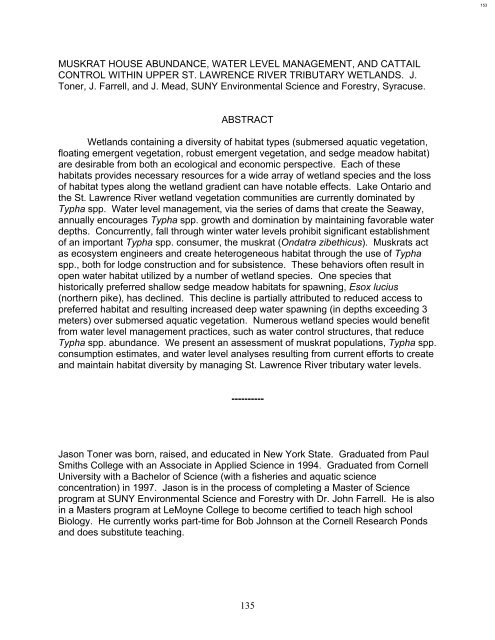Proceedings of the Sixty-first Annual Meeting of the Northeastern ...
Proceedings of the Sixty-first Annual Meeting of the Northeastern ...
Proceedings of the Sixty-first Annual Meeting of the Northeastern ...
You also want an ePaper? Increase the reach of your titles
YUMPU automatically turns print PDFs into web optimized ePapers that Google loves.
153<br />
MUSKRAT HOUSE ABUNDANCE, WATER LEVEL MANAGEMENT, AND CATTAIL<br />
CONTROL WITHIN UPPER ST. LAWRENCE RIVER TRIBUTARY WETLANDS. J.<br />
Toner, J. Farrell, and J. Mead, SUNY Environmental Science and Forestry, Syracuse.<br />
ABSTRACT<br />
Wetlands containing a diversity <strong>of</strong> habitat types (submersed aquatic vegetation,<br />
floating emergent vegetation, robust emergent vegetation, and sedge meadow habitat)<br />
are desirable from both an ecological and economic perspective. Each <strong>of</strong> <strong>the</strong>se<br />
habitats provides necessary resources for a wide array <strong>of</strong> wetland species and <strong>the</strong> loss<br />
<strong>of</strong> habitat types along <strong>the</strong> wetland gradient can have notable effects. Lake Ontario and<br />
<strong>the</strong> St. Lawrence River wetland vegetation communities are currently dominated by<br />
Typha spp. Water level management, via <strong>the</strong> series <strong>of</strong> dams that create <strong>the</strong> Seaway,<br />
annually encourages Typha spp. growth and domination by maintaining favorable water<br />
depths. Concurrently, fall through winter water levels prohibit significant establishment<br />
<strong>of</strong> an important Typha spp. consumer, <strong>the</strong> muskrat (Ondatra zibethicus). Muskrats act<br />
as ecosystem engineers and create heterogeneous habitat through <strong>the</strong> use <strong>of</strong> Typha<br />
spp., both for lodge construction and for subsistence. These behaviors <strong>of</strong>ten result in<br />
open water habitat utilized by a number <strong>of</strong> wetland species. One species that<br />
historically preferred shallow sedge meadow habitats for spawning, Esox lucius<br />
(nor<strong>the</strong>rn pike), has declined. This decline is partially attributed to reduced access to<br />
preferred habitat and resulting increased deep water spawning (in depths exceeding 3<br />
meters) over submersed aquatic vegetation. Numerous wetland species would benefit<br />
from water level management practices, such as water control structures, that reduce<br />
Typha spp. abundance. We present an assessment <strong>of</strong> muskrat populations, Typha spp.<br />
consumption estimates, and water level analyses resulting from current efforts to create<br />
and maintain habitat diversity by managing St. Lawrence River tributary water levels.<br />
----------<br />
Jason Toner was born, raised, and educated in New York State. Graduated from Paul<br />
Smiths College with an Associate in Applied Science in 1994. Graduated from Cornell<br />
University with a Bachelor <strong>of</strong> Science (with a fisheries and aquatic science<br />
concentration) in 1997. Jason is in <strong>the</strong> process <strong>of</strong> completing a Master <strong>of</strong> Science<br />
program at SUNY Environmental Science and Forestry with Dr. John Farrell. He is also<br />
in a Masters program at LeMoyne College to become certified to teach high school<br />
Biology. He currently works part-time for Bob Johnson at <strong>the</strong> Cornell Research Ponds<br />
and does substitute teaching.<br />
135
















